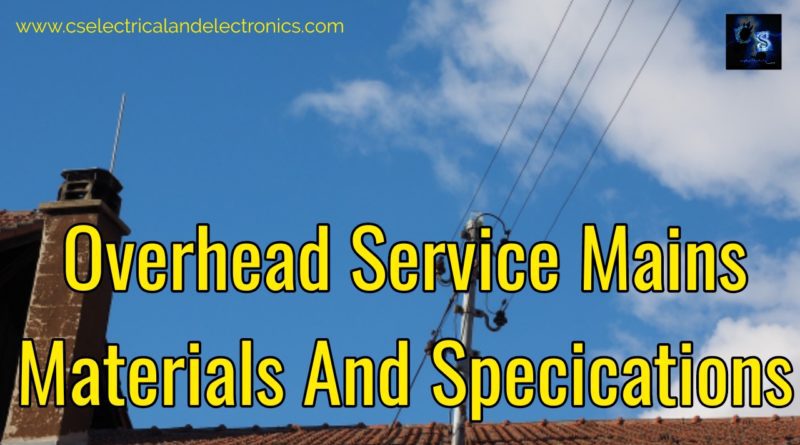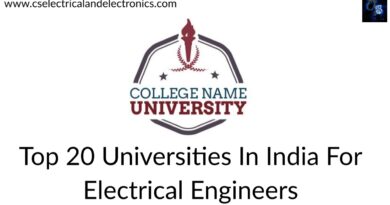Overhead Service Mains Materials And Specification
Hello everyone, in this article, I will discuss overhead Service Mains materials and specification, which means materials used in overhead service mains, and specification of materials that are used in overhead service mains. You can also catch me @ Instagram – Click Here.
Before starting the article if you want to watch a video related to electrical estimation and costing, you can watch my YouTube videos – Click Here
Also read – Transmission, Distribution, And Utilization Question And Answers.
Overhead Service Mains
The figure shows the overhead service connection for tapping a single-phase supply.
01. The topmost wire is called G.I. Messenger wire which takes mechanical load is usually 10 SWG for load not exceeding 2.5 KW. (For 3-Phase connection power load up to 12 KW 6 SWG ). Messenger wire is of galvanized iron. This messenger wire is tied at both ends to the supporting pipe at one side and to the pole on the other side. The messenger wire is electrically broken at both sides by means of 1.1KV break insulators.
02. Double sheathed or weatherproof PVC cables of aluminum or copper are drawn through Reel Insulator which is suspended to messenger wire. Service cable carries electricity from a low tension line to a consumer meter board. The cables are taken up to the meter board through the service pipe. This service pipe is fixed to the support pipe by clamps as shown.
03. If the horizontal distance between the pole and support pipe is more than 20m, then in order to maintain support pipe Vertical a stay of GI wire is required to the pipe again which is to be broken at the midpoint by means of 1.1 kV break Insulator aa shown in the above figure. A suitable earthing is to be provided to the meter.
Service Mains Materials And Specifications
1) Break Insulator
Made of Porcelain 1.1 kV.
The purpose of the brake insulator is to isolate messenger wire from pole, it is an insulator that is used for isolation. Only two break insulators are used in overhead service mains one insulator at the pole side and another insulator at the meter board side.
2) G.I. Messenger wire
Made of G.I. of 10 SWG / 8 SWG / 6 SWG for 1 KW / 2.5 KW / 12 KW loads respectively.
As you can see messenger wire in the above figure, the messenger wire purpose is to give mechanical support to service cables and also for reel insulators.
3) Service cables
Double sheathed PVC aluminum cable of appropriate size depending upon the load 250 V grade for single phase and 500 V grade for three phases. Nowadays aluminum cables are used before that instead of aluminum conductor copper conductors where used, but the cost of copper cables where high so it is now replaced by aluminum cables.
4) Reel Insulators
Made of Porcelain 12.5 mm diameter.
The purpose of the reel insulator is to make the distance to be maintained between two cables and also two avoid short circuits sometimes. Now the question is how many reel insulators we must use? It depends upon the distance between pole and service pipe if the distance is more than more reel insulators are required and if the distance is less than fewer reel insulators are required.
5) Support Pipe
40mm diameter 3mm thick G.I. Pipe 1.8m long for single-phase or 50 mm diameter, 3mm thick G.I pipe of 1.8m long for three-phase service connection.
The purpose of the support pipe is to support the service pipe.
6) Meter Board
Well seasoned varnished teak wood Board (WVTWB) of the suitable size for the main meter board.
A meter board is a device that records how much energy is consumed by a consumer.
7) Service Pipe
Made of PVC 2mm thick of appropriate diameter depending upon the size and the number of cables to be taken through the pipe of 2 m in length with 3 numbers of bends of the same diameter.
Through the service pipe, the cables are drawn to the meter board as shown in the above figure. The service pipe is fixed to the support pipe using clamps, The support pipe gives support to the service pipe.
8) Clamps
M.S clamps for fixing support and service pipe.
Clamps are used at two sides one side if for pothead i.e., to fix a pothead to the pole and another is at the meter side to fix the service pipe to support pipe.
9) Earthing
A complete set with a 40 mm diameter G.I pipe of 3 mm thick 2.5 m long, 12.5 mm hole drilled along the length at an interval of 300 mm. The pit of suitable size is to be filled with different layers of salt and charcoal.
10) Fuse unit
Made of Porcelain with suitable voltage grade and current rating.
Fuse unit consists of a protective device i.e., fuse, the fuse is a safety device that breaks the circuit during a fault condition.
Some more points related to overhead service mains
We all know that overhead service mains is a system of transmitting electricity from low tension line to meter board, but it has some advantages and disadvantages. Advantages are fault location is easy if any fault occurs it can be easily identified and it can be easily repaired, Cost of overhead service main is less compared to the cost of underground service mains, and you can also increase the capacity of the line. The disadvantages of overhead service mains are it is not safe, affected by sun or rain, not good in appearance, etc.
Now I will tell you all the cost of all materials
Cost of Materials
- 01. Reel Insulators – The cost of reel insulator is 3 to 5 rupees.
- 02. Break Insulators – The cost of break insulator is 10 rupees.
- 03. Messenger wire – The cost of Messenger wire is 250 – 300 per roll.
- 04. Service cable – The cost of aluminum service cable is 14 to 20 rupees per meter.
- 05. PVC Pipe – The cost of PVC pipe is 20 to 25 rupees per meter.
I hope this may help you all a lot. Thank you for reading.
Tags: Overhead Service Mains Materials And Specification.
Also, read:
- 10 Tips To Maintain Battery For Long Life, Battery Maintainance
- 10 Tips To Save Electricity Bills, Save Money By Saving Electricity
- 100 (AI) Artificial Intelligence Applications In The Automotive Industry
- 100 + Electrical Engineering Projects For Students, Engineers
- 1000+ Control System Quiz, Top MCQ On Control System
- 1000+ Electrical Machines Quiz, Top MCQs On Electrical Machines
- 1000+ MATLAB Simulink Projects For MTech, Engineering Students
- 50 Tips To Save Electricity At Home, Shop, Industry, Office
- 50+ Question And Answer On The Substation, Electrical Question
- 500+ Matlab Simulink Projects Ideas For Engineers, MTech, Diploma
- 500+ Projects For Diploma Electrical, Electronics Student, Diploma Project
- Active Cell Balancing Using A Flyback Converter Simulation In Matlab Simulink
- AI Artificial Intelligence Applications In Electric Vehicles | Future?
- AI Tools For Electronic Circuit Design, Which Is Best?
- Applications Of Artificial Intelligence (AI) In Renewable Energy
- Automotive Industry Or VLSI Chip Industry ? Which Is Best?
- Basic Electrical Engineering, Terms, Definitions, SI Unit, Formula
- Basic Electrical Quiz, Take Online Test On Basic Electrical, Electrical Quiz
- Battery C Rate Online Calculator With Time Calculation
- Battery Management Systems In Electric Vehicles, BMS Operations
Author Profile
- Chetu
- Interest's ~ Engineering | Entrepreneurship | Politics | History | Travelling | Content Writing | Technology | Cooking
Latest entries
 All PostsApril 13, 2024What Is TCM, Transmission Control Module, Working, Purpose,
All PostsApril 13, 2024What Is TCM, Transmission Control Module, Working, Purpose, All PostsApril 12, 2024Top 100 HiL hardware in loop Interview Questions With Answers For Engineers
All PostsApril 12, 2024Top 100 HiL hardware in loop Interview Questions With Answers For Engineers All PostsMarch 22, 2024Driver Monitoring Systems In Vehicles, Working, Driver Sleepy Alert
All PostsMarch 22, 2024Driver Monitoring Systems In Vehicles, Working, Driver Sleepy Alert All PostsMarch 10, 2024Top 100 Automotive Interview Questions With Answers For Engineers
All PostsMarch 10, 2024Top 100 Automotive Interview Questions With Answers For Engineers








